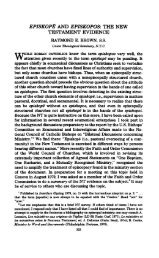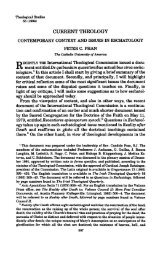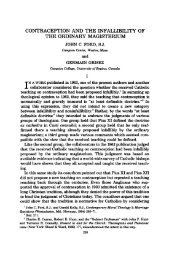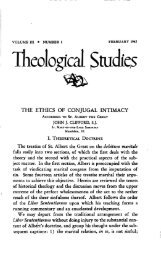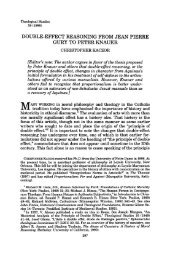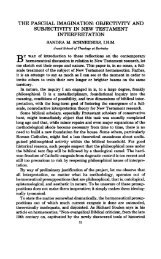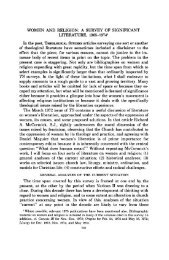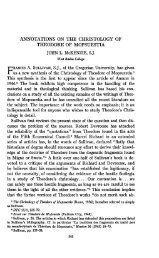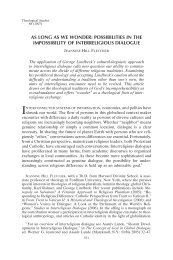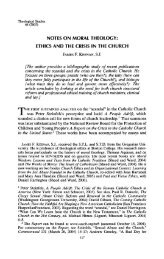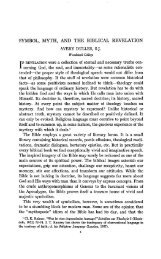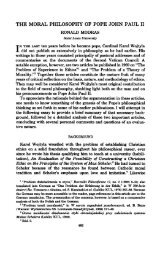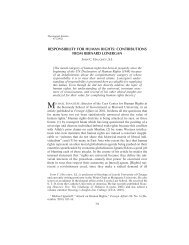Theology for Artisans of a New Humanity - Theological Studies
Theology for Artisans of a New Humanity - Theological Studies
Theology for Artisans of a New Humanity - Theological Studies
Create successful ePaper yourself
Turn your PDF publications into a flip-book with our unique Google optimized e-Paper software.
CHALLENGE OF SEGUNDO 129<br />
a seeming irreverence, but he believes such a heuristic device is necessary<br />
to waken the discipline <strong>of</strong> theology from its present ideological<br />
slumber.<br />
Paradoxically, however, a parallel aim <strong>of</strong> the book is to justify the<br />
necessity <strong>of</strong> ideologies; <strong>for</strong>, aside from the pejorative sense <strong>of</strong> ideology as<br />
a sacralization <strong>of</strong> vested interests, the author also alludes to a more<br />
neutral conception: ideology as a person's basic system <strong>of</strong> goals and<br />
values, plus the concrete means selected to achieve them. On the<br />
phenomenological level, he sees a strong similarity in practice between<br />
a faith, such as Christianity, and an ideology, such as Marxism. 11 Thus,<br />
everyone embraces some system <strong>of</strong> means and ends, that is, some<br />
ideology; without the latter any effective action in history would be<br />
impossible.<br />
A number <strong>of</strong> issues related to this are treated at length, such as<br />
eschatology, the problem <strong>of</strong> violence, and a proposed reconciliation <strong>of</strong><br />
the basic disputes <strong>of</strong> the Re<strong>for</strong>mation. Of singular importance is the<br />
question <strong>of</strong> the use <strong>of</strong> Scripture. For Segundo, the God revealed in the<br />
two Testaments is always known through a series <strong>of</strong> responses to<br />
different historical events; thus the unchangeable faith is always incarnated<br />
in changeable ideologies, which constitute "a bridge between our<br />
conception <strong>of</strong> God and the real-life problems <strong>of</strong> history" (p. 116). In one<br />
specific set <strong>of</strong> circumstances, then, God was understood as calling <strong>for</strong> the<br />
slaying <strong>of</strong> neighboring peoples; in another and different historical situation,<br />
his message was one <strong>of</strong> nonresistance to evil.<br />
What, then, is the relation <strong>of</strong> the Bible to contemporary situations,<br />
such as the phenomenon <strong>of</strong> massive human suffering in Latin America?<br />
One method <strong>of</strong> answering this would involve searching the Scriptures<br />
<strong>for</strong> the paradigmatic situations which most closely resemble contemporary<br />
events, and accepting these as the correct faith responses <strong>for</strong> today.<br />
But such a procedure appears antiscientific and unreal, inasmuch as<br />
"there seems to be less and less sense in trying to look <strong>for</strong> similar<br />
situations in cultural milieus dating back thirty-five centuries, particularly<br />
since the pace <strong>of</strong> history seems to be accelerating every day" (pp.<br />
117-18).<br />
In clarifying his own position, Segundo utilizes the concepts <strong>of</strong> communications<br />
theory. He distinguishes between simple learning (protounderstanding<br />
<strong>of</strong> the reality <strong>of</strong> God. On the latter topic, a fuller development may be<br />
found in Nuestra idea de Dios (Buenos Aires: Ediciones Carlos Lohlé, 1970). Segundo's<br />
ideas on sacramental theology are amplified in Los sacramentos hoy (Buenos Aires:<br />
Ediciones Carlos Lohlé, 1971).<br />
11 A preliminary sketch <strong>of</strong> these ideas appeared in "Fe e ideología," Perspectivas de<br />
diálogo 9 (1974) 227-33. Segundo had earlier published a series <strong>of</strong> articles on this and<br />
related topics in 1968 and 1969 in the same journal. A clear summary <strong>of</strong> his approach<br />
may be found in "Del ateismo a la fe," ibid. 3 (1968) 44-47.



